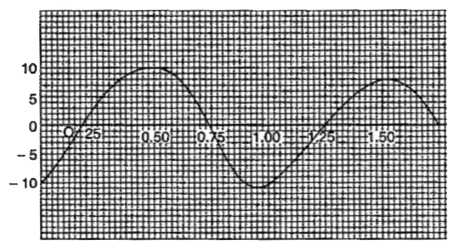For the wave described in the last problem plot the displacement ( y ) versus ( t) graphs for x = 0.2 and 4 cm. What are the shapes of these graphs ? In which aspects doesthe oscillatory motion in travelling wave differ from one point to another : amplitude, frequency or phase ?
The transverse harmonic wave is y(x,t)=3.0[36t+0.018x+π4]
For x = 0
y(0,t)=3.0sin(36t+π4) ...(i)
Here w=πT=36,T=2π36=π18sec.
Topper's Solved these Questions
- WAVESBOOK - VIKRAM PUBLICATION ( ANDHRA PUBLICATION)CHAPTER - WAVESEXERCISE - ADDITIONAL EXERCISES
6 Videos
- WAVESBOOK - VIKRAM PUBLICATION ( ANDHRA PUBLICATION)CHAPTER - WAVESEXERCISE - LONG ANSWER QUESTIONS
6 Videos
- WAVE OPTICS BOOK - VIKRAM PUBLICATION ( ANDHRA PUBLICATION)CHAPTER - WAVE OPTICS EXERCISE - Problems
6 Videos
Similar Questions
For the wave described in the displacement (y) versus (t) graphs for x = 0, 2 and 4 cm. What are the shapes of these graphs ? In which aspects does the oscillatory motion in a travelling wave differ from one point to another : amplitude, frequency or phase ?
View SolutionFor the wave described in exercise 27 plot the displacement (y) versus (t) graphs for x=0,2 and 4m. What are the shaps of these graphs ? In which aspects does the oscillatory motion in travelling wave differ from one point to another amplitude, frequency or phase?
View Solution
Knowledge Check
The equation y=4+2sin(6t−3x) represents a wave motion. Then, wave speed and amplitude, respectively are
Awave speed 1 unit, amplitude 6 unitBwave speed 2 unit, amplitude 2 unitCwave speed 4 unit, amplitude 1/2 unitDwave speed 1/2 unit, amplitude 5 unitFor the harmonic travelling wave y=2cos2pi(10t-0.0080x+3.5) where x and y ar in cm and t is in second. What is the phase diffference between the oscillatory motion at two points separated by a distance of
A4mB0.5mCλ2D3λ4 (at a given instant of time)
For the wave y= 3.0 sin(36t + 0.018x + pi/4) plot the displacement (y) versus (t) graphs for x=0,. What is the shaps of the graph ? In which aspects does the oscillatory motion in travelling wave differ from one point to another amplitude, frequency or phase?
View SolutionIn the following graph. the displacements of a particle of a progressive wave at different times are shown. Refer to this graph and answer the questions given below.

Which one ·or the following is the amplitude of the wave?
View SolutionFor the harmonic travelling wave y=2cos2pi(10t-0.0080x+3.5) where x and y ar in cm and t is in second. What is the phase diffference between the oscillatory motion at two points separated by a distance of
View SolutionA transverse harmonic wave on a string is described by y(x,t)=3.0sin(36t+0.018n+π/4), where x and y are in cm an t in sec. The positive direction of x is from left to right.
(a) Is this a travelling wave or a stationary wave?
(b) What are its amplitude and frequency?
View SolutionA wave travels along the positive x-direction with a speed of 20ms−1. The amplitude of the wave is 0.20 cm and the wavelength 2.0 cm. (a) Write a suitable wave equation which describes this wave. (b) What is the displacement and velocity of the particle at x = 2.0 cm at time t = 0 according to the wave equation written ? Can you get different values of this quantity if the wave equation is written in a different fashion ?
View SolutionMany interesting wave phenomenon in nature cannot just be described by a single wave, instead one must analyze complex wave forms in terms of a combinations of many travelling waves. To analyze such wave combinations, we make use of the principle of superposition which states that if two or more travelling waves are moving through a medium and combine at a given point, the resultant displacement of the medium at that point is sum of the displacement of individual waves. Two pulses travelling on the same string are described by
y1=5(3x−4t)2+2 and y2=−5(3x+4t−6)2+2
The direction in which each pulse is travelling
View Solution
